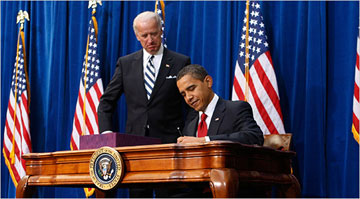
President Obama, with Vice President Joseph R. Biden Jr., signing the $787 billion stimulus bill at the Denver Museum of Nature and Science in February. (via NYTimes.com, photo by Ruth Fremson/The New York Times)
Talking about federal arts funding in America can be very confusing because of the many facts and figures. So, in an effort to understand the current and historic levels of federal funds that artists of all types have enjoyed, and to better understand the economic impact of the arts in America, I have compiled the following data from online sources for Part 1 of this two-part series. Part 2 is an interview with both Congressional Arts Caucus Co-Chairs, Rep. Louise Slaughter (D-NY) and Rep. Todd Russell Platts (R-PA) about federal funding for the arts, and will post on Thursday.
STIMULUS ARTS FUNDING TODAY
Current funding for the National Endowment of the Arts (NEA): $155 million
2009 Stimulus Bill
American Recovery and Reinvestment Act of 2009 (aka 2009 Stimulus Bill): $787 billion
Arts portion of the Stimulus Bill: $50 million (0.006%)
- 40% for state & regional arts organizations
- 60% to arts projects competing for NEA grants
Other arts-related funding in the Stimulus Bill:
- $150 million for infrastructure repairs at the Smithsonian
What the Arts Does For America Economically (via Americans for the Arts)
- There are approximately 100,000 nonprofit arts organizations in America, which spend $63.1 billion annually.
- There are more full-time jobs (incl. accountants, designers, plumbers, union workers & engineers) supported by the nonprofit arts organizations than are in accounting, public safety officers, even lawyers and just slightly fewer than elementary school teachers.
- America’s nonprofit arts & culture industry generates $166.2 billion economic activity annually, including 5.7 million jobs, generating $29.6 billion in government revenue, of which $12.6 billion is federal revenue.
HISTORIC FEDERAL ARTS FUNDING
Arshile Gorky, "Aerial Map" (1936-7), a Federal Art Project (FAP) mural (via Brown Univ. website)
Arts Stimulus during the Great Depression (1930s)
The Emergency Relief Appropriation Act of 1935, President Franklin Delano Roosevelt’s “stimulus,” made the arts a priority. The Works Progress Administration (WPA) was the largest New Deal agency and it included the Federal Arts Project (FAP).
1935-1943 WPA “Stimulus”: $11 billion*
$35 million (0.318%) of the WPA’s budget was allocated to FAP, and according to Encyclopedia Britannica:
…[it] employed more than 5,000 artists at its peak in 1936 and probably double that number over the eight years of its existence. It produced 2,566 murals, more than 100,000 easel paintings, about 17,700 sculptures, nearly 300,000 fine prints, and about 22,000 plates for the Index of American Design, along with innumerable posters and objects of craft.
President Johnson signs the National Foundation on the Arts and the Humanities Act, establishing the National Endowment for the Arts and the National Endowment for the Humanities, on September 29, 1965. (photo via NEA website)
During its life, the FAP employed many American artists who would later become the greats of 20th-century American art, including Berenice Abbott, Arshile Gorky, Jacob Lawrence, Mark Rothko, and many others.
History of Federal Funding (post-1965)
In 1965, the US Congress created the National Endowment of the Arts (NEA) as an independent agency of the federal government. Since 1965, the NEA has awarded more than 130,000 grants totaling more than $4 billion (source).
Appropriation History (complete list):
- 1966 — $2,898,308
- 1970 — $9,055,000
- 1979 — $149,585,000 (which the LA Times estimated is worth $434 million in today’s dollars)
- 1980 — $154,610,000
- 1990 — $171,255,000
- 2000 — $97,627,600
- 2009 — $155,000,000